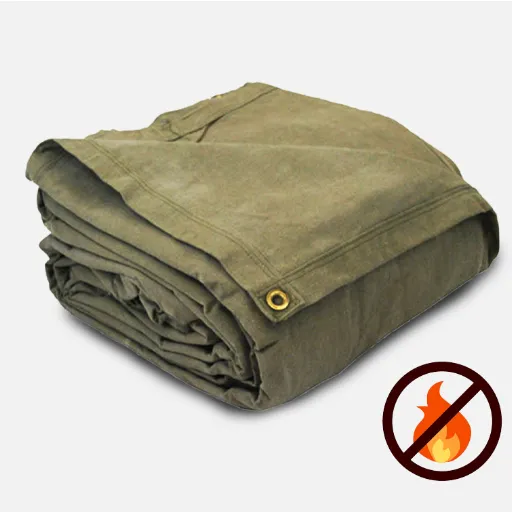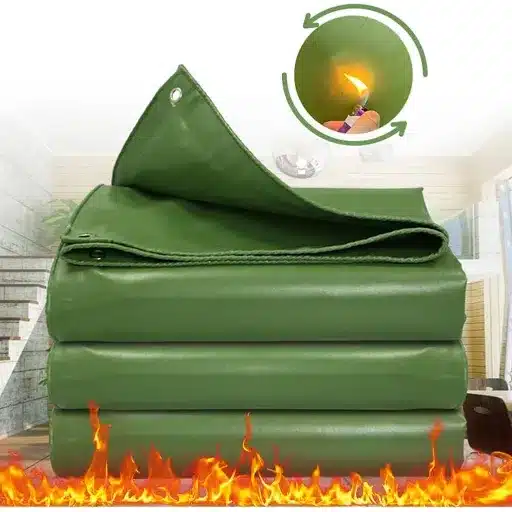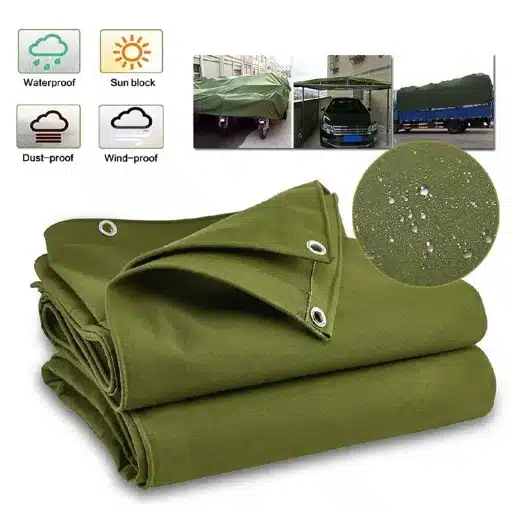A tarpaulin is the most important protective gear in dealing with valuable equipment, weatherproofing outdoor areas, or performing heavy-duty jobs in difficult situations. Thick tarps that are specially made to be heavy-duty, waterproof, and UV resistant are real workhorses, indeed, they resist the weather and provide reliable performance when it is most needed. Whether you’re a homeowner who wants to protect your property, a contractor who needs strong solutions at a job site, or an outdoor adventurer planning a trip, this guide is for you. In this article, we will cover everything about thick tarps, starting with their main features and advantages and ending with the best tips on selecting the right one for your particular needs. Get set to unveil the flexibility and unmatched security that thick tarps grant!
Understanding Heavy Duty Tarps
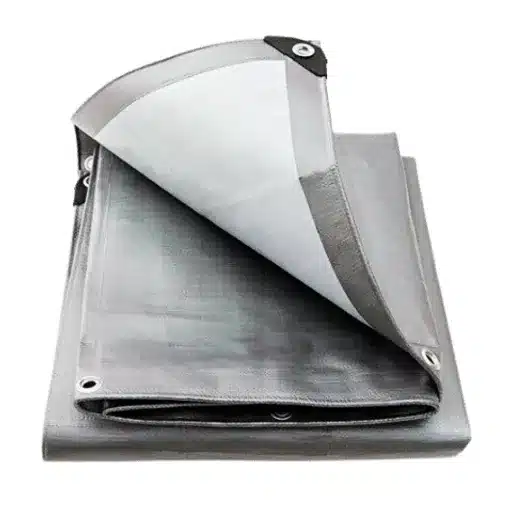
What is a Heavy Duty Tarp?
A heavy-duty tarp is a strong, versatile sheet made of different materials such as polyethylene, vinyl, or canvas, and it is designed to last for a long time and provide good protection even in difficult situations. These tarps are made to endure bad weather such as heavy rain, strong winds, and extreme sunlight, which makes them suitable for outdoor and industrial use. Heavy-duty tarps usually come with features like reinforced borders, grommets that resist rust, and very high tear-resistance, all of which keep them in good shape during long use. Some of the common uses for heavy-duty tarps include covering and protecting things like equipment, vehicles, and construction materials, and sometimes, they are even used as temporary shelters. Their reliability and flexibility make them the preferred option for both professionals and consumers who need long-lasting, effective coverage.
🛡️ Key Defining Features
- ✓
Constructed from durable materials (polyethylene, vinyl, or canvas) - ✓
Reinforced borders and rust-resistant grommets - ✓
High tear-resistance for extended durability - ✓
Withstands heavy rain, strong winds, and extreme sunlight
Common Materials Used in Heavy Duty Tarps
Heavy-duty tarps are usually made from materials that can withstand harsh conditions, are weather resistant, and strong enough for a variety of applications. The most typical materials used are:
1. Polyethylene (PE)
It has a light weight but is very durable at the same time; it is also known for being waterproof, UV-resistant, and tolerant to harsh conditions. These are construction and outdoor setting materials of choice.
2. Vinyl (PVC)
Heavy-duty and strong in nature, vinyl tarps are meant for industrial use. Tearing, chemical, and extreme weather resistance are some of the features that they offer which is why they are considered to be very dependable in the long run.
3. Canvas
Giving off yin-yang durability and breathability, canvas tarps that are often made from cotton or polyester are suitable for covering equipment that is susceptible to condensation build-up. These are sometimes treated with water, mildew, and fire resistant materials.
4. Mesh
These tarps are not completely solid; they created from lightweight and durable materials such as polyethylene or nylon and are used in areas where moderate protection, shade and airflow are required.
5. Rubber-Coated Fabric
These tarps are resistant to abrasion and punctures. Hence, they are heavy-duty industrial applications or where maximum protection against impact is needed.
💡 Selection Tip: The material choice is based on several factors like the use for which it is intended, the environmental conditions in which it will be placed, and the budget. Each type of material has its own advantages making heavy-duty tarps a great solution for different tasks by being able to cater to various needs.
Benefits of Using Heavy-Duty Tarps
Heavy-duty tarps give a multitude of benefits through their use in various applications leaving no doubt about their being a very practical investment. The following are the major advantages:
Top Benefits at a Glance
⚡ Durability and Longevity
Made with durable materials that withstand harsh conditions, UV rays, and frequent mechanical stresses, resulting in less frequent replacements
☔ Weather Resistance
Excellent defense against rain, wind, snow, and sun, protecting construction sites, vehicles, and outdoor equipment effectively
🔄 Versatility
Can be utilized for numerous purposes from industrial and agricultural applications to camping and temporary shelters
💰 Cost-Effectiveness
Helps avoid repair and replacement costs by safeguarding valuable assets, with reusability providing additional economic benefits
🌱 Eco-Friendly Options
Increasingly available in recyclable materials or sustainable manufacturing processes, supporting environmental preservation
Search trends show a growing interest in heavy-duty tarps for residential and commercial purposes, indicating their increasing popularity and the importance of weather protection in various industries. The choice of a heavy-duty tarp directly contributes to effective resource management and long-term cost savings.
Types of Thick Tarps
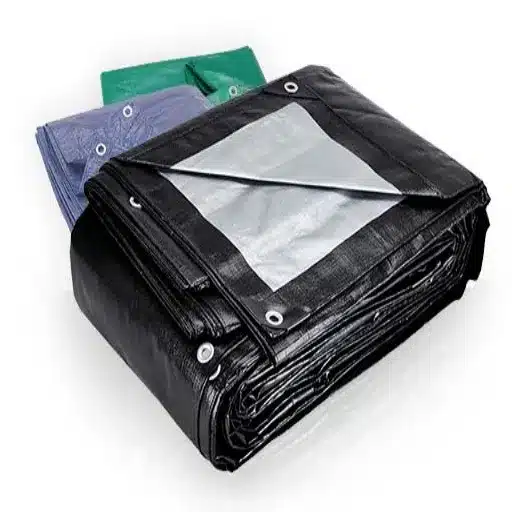
Poly Tarps vs. Canvas Tarps
Poly tarps and canvas tarps have their own separate characteristics which differentiate them by making them suitable for different purposes. Poly tarps are lightweight, waterproof, and made from polyethylene material and they are the best option for those areas in needing total water resistance such as outdoor equipment or construction sites. Moreover, they are UV resistant thus the sun will not spoil them even after long exposure. The results of a search trend analysis indicate that poly tarps are being increasingly used for temporary shelter, pool covering, and garden protection in houses which is becoming a major residential use of the product.
Canvas tarps on the contrary are heavier, more durable and made from cotton or a mix of natural materials. They provide the best breathable coverage thereby reducing the risk of condensation and mold which explains their great popularity in ventilated covering of machinery, vehicles, or cargo. Nevertheless, canvas tarps are more suited to long-term indoor or semi-covered applications where moisture build-up is a concern. Poly tarps rank first in search queries for waterproof needs while canvas tarps have a steady interest in markets that prioritize durability and natural materials. The two are different yet similar as they cater exactly to different needs such as waterproofing, breathability, or sustainability.
Super Heavy Duty Tarps: Features and Uses
Super heavy duty tarps are constructed for the utmost durability and weather resistance making them the best choice for very hard applications. These tarps usually are equipped with strengthened edges, heavy-duty grommets, and covered with UV-treated materials that guarantee their long lasting performance. They are also the most reliable ones in the protection area and hence used extensively in construction sites, agricultural storage, and disaster relief among other places.
The most recent updates from the search engine of show that the searches about super heavy duty tarps open up people’s main concerns like “extreme weather protection,” “tear resistance,” and “long-term outdoor use.” Thus the users want tarps which after use can be worn and still provide coverage against rain, wind and sun for long periods. When buying a super heavy duty tarp there are things such as the thickness of the material (measured in mils), waterproofing ability, and resistance to mildew or rot that are very important. The combination of these characteristics and expert handling will lead to achieving effective and durable solutions for many needs.
🏆 Super Heavy Duty Tarp Features
🔨 Reinforced Construction
Strengthened edges and heavy-duty grommets for maximum stability
☀️ UV Treatment
UV-treated materials for long-lasting outdoor performance
💪 High Mil Rating
Thick materials (16+ mils) for superior tear resistance
🛡️ Weather Protection
Complete waterproofing and mildew/rot resistance
Hay Tarps: Protecting Your Bales
Hay tarps play a pivotal role in making the harvested bales impervious to bad weather and the elements. The most current information from search trends of indicates that farmers and agricultural workers are progressively finding solutions for how to keep hay dry in winter and best tarps for hay storage. The method of using hay tarps to avoid moisture entering which could otherwise lead to mold development and loss of hay’s nutrition value is both economical and effective. Besides, using the UV resistant and waterproof tarps, the users will not only preserve their stored hay but they will also save their time and resources as the hay will not need to be turned over as often. Wind and rainfall are two major threats to stored hay; hence, proper anchoring methods and quality tarp materials are the two things that will help one to ensure and maintain the best storage conditions throughout the year.
🌾 Hay Tarp Best Practices
- Choose UV-Resistant Materials: Protects against sun degradation over long-term storage
- Ensure Complete Waterproofing: Prevents moisture entry that leads to mold and nutrient loss
- Secure Proper Anchoring: Protects against wind damage and ensures stable coverage
- Regular Inspection: Check for tears or gaps that could compromise protection
- Seasonal Maintenance: Adjust coverage as weather conditions change throughout the year
Durability and Performance
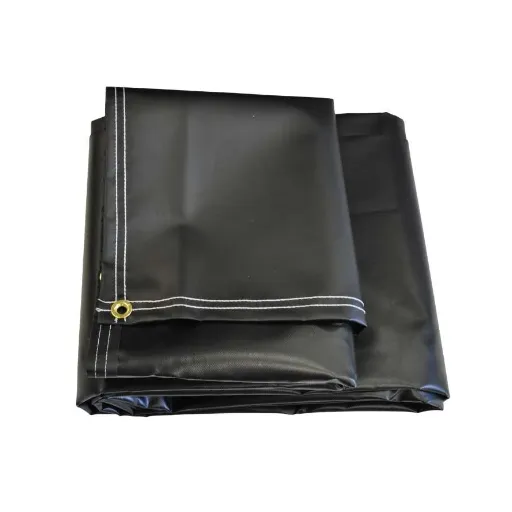
Understanding Mil Ratings in Tarps
Mil ratings are a method of measuring the thickness of a tarp and one mil is equal to one-hundredth of an inch (0.001 inch). This metric is already seen as a decisive point in the measurement of the durability and quality of a tarp. The stronger the quality, the thicker the tarps and the higher the mil rating of the tarp being torn, punctured, or otherwise exposed to elements, even the harshest, like wind, rain, and sunlight, for example. Consequently, lightweight tarps usually have a thickness of about 5 to 10 mils and are meant for temporary use, while heavy-duty tarps that can go as far as 20 mils and more are great for very long protection even in hard conditions.
In this case, when one is selecting a tarp, the mil rating should be the primary factor depending on the application. For various agricultural purposes like covering hay bales, one should not hesitate to go for thick tarps with high mil ratings that could endure weather wear and consequently, the mil rating would help the user to be assured of protection from the sun and rain while at the same time reducing the frequency of replacements. Knowledge of mil ratings paves the way for the customers to get the best by advocating for a balance between performance and cost-effectiveness tailored to their needs.
📊 Mil Rating Guide
| Mil Rating | Thickness | Durability Level | Best Applications |
|---|---|---|---|
| 5-10 mils | 0.005″ – 0.010″ | Lightweight | Temporary coverage, light-duty protection |
| 11-15 mils | 0.011″ – 0.015″ | Medium | Construction sites, equipment covering |
| 16-20+ mils | 0.016″ – 0.020″+ | Heavy-Duty | Agricultural, industrial, extreme conditions |
How to Choose the Right Thickness for Your Needs
When making the decision regarding the thickness of your tarp, it is vital to think about the purpose, the climatic conditions and your budget. Current analysis and trends indicate that thinner tarps (5-10 mil) are the best for short-term uses like temporary covering or light-duty protection as they are cheaper and easier to handle. Meanwhile, medium-thickness tarps (11-15 mil) would last longer and thusbe good for moderate outdoor applications like covering construction sites or equipment where extra strength is needed. For heavy-duty purposes like the agricultural or industrial use one should buy 16mil thick tarps or more. These would not only last long but they would also offer the best protection against tearing, UV rays, and bad weather.
According to ‘s search-related data, one can conclude that longevity and weather resistance are the main factors for many users when choosing tarp thus they are usually directed to thick options for Environment demanding conditions. However, if the primary concern is portability and cost, then lighter tarps will still be a popular choice. After all these considerations, it would be easier to determine the right tarp thickness for your needs.
🎯 Thickness Selection Guide
🔸 Light-Duty (5-10 mil)
Best For: Temporary covering, light protection
Advantages: Lower cost, easy handling, portable
Ideal Users: Budget-conscious, short-term needs
🔸 Medium-Duty (11-15 mil)
Best For: Construction sites, equipment covering
Advantages: Good balance of strength and cost
Ideal Users: Contractors, moderate outdoor use
🔸 Heavy-Duty (16+ mil)
Best For: Agricultural, industrial, extreme conditions
Advantages: Maximum protection, longest lifespan
Ideal Users: Farmers, industrial operations
Factors Affecting Tarp Durability
There are several main factors that have a direct impact on tarp life, making sure that it can withstand a variety of conditions. Among them, the material composition takes priority as the least durable materials are likely to be fabric-based while polyethylene and vinyl are the most durable and thus the cheapest. Thickness, measured in mils, is another factor; thick tarps will last longer than thin ones when it comes to heavy usage but they will be less portable.
UV resistance is an important trait, especially for those tarps that are going to be outside for extended periods. Sun-degrading makes these UV-treated tarps unsuitable for applications where sunlight is the main factor of the conditions. Weather conditions, like strong winds and heavy rains, test even the most durable of tarps and thus the need for reinforced hems and grommets for increased stability becomes even more important.
Many users are asking frequently about their tarps’ lifespan, which shows that durability is one of the most important traits in deciding whether to choose or reject a certain tarp, reveals ‘search data. When made, the decision depends on the usage of the tarp and subsequently the required features such as material type, reinforcement, and protective coatings that are aligned with those demands. Proper storage and maintenance will also play an essential role in a tarp’s longevity such that the tarp remains a reliable solution for many years ahead.
⚙️ Key Durability Factors
- Material Composition: Polyethylene and vinyl offer superior durability compared to fabric-based options
- Thickness (Mil Rating): Higher mil ratings provide better resistance to tears and punctures
- UV Treatment: Essential for extended outdoor exposure to prevent sun degradation
- Weather Conditions: Strong winds and heavy rains require reinforced hems and grommets
- Reinforcement Quality: Double stitching and reinforced edges extend lifespan significantly
- Proper Maintenance: Regular cleaning and correct storage practices maximize longevity
Custom Tarps and Applications

Custom Tarps Benefits
Custom tarps are offering more ways that no other tarps can be. Becoming one of the major gain, their adjustment to the needs of the customers, allows to get the exact fitting for the dosed with different shapes or specific applications. Alongside being durable very often, they are also being made out of high-quality materials like vinyl or polyethylene, and their durability is further increased by the use of extra materials based on the use for that. Another significant advantage is resistance to different weather conditions, including the ones due to UV rays, waterproof coatings, and even the application of advanced fire-retardant treatments.
According to ‘s latest search trends, the topics of custom tarps have become a discussion mainly concerning whether they can be used for commercial or singular personal projects. Custom tarps make up for the demand of basic functionality through the combination of design flexibility and robust performance. Their adaptivity and value-added features render them a superior long-term investment that is very well suited for even the most stringent requirements.
✨ Why Choose Custom Tarps?
Perfect Fit
Exact measurements for unique shapes and specific applications
Premium Materials
High-quality vinyl or polyethylene with enhanced durability
Design Flexibility
Choose colors, features, and specifications to match your needs
Advanced Protection
UV resistance, waterproof coatings, and fire-retardant treatments
Applications for Custom Heavy Duty Tarps
Custom heavy-duty tarps are multifunctional and durable products that can efficiently serve diverse needs in different sectors. The most frequent usages according to the newest search trends and inquiries are:
🔧 Equipment and Machinery Protection
The prevention of equipment and machinery from harsh weather conditions and other environmental factors is among the main uses of custom heavy-duty tarps. The protection level is maximized due to durability and the ability to get the tarps customized according to the exact size.
🌾 Farm Use
Covering or insulating crops, hay, or even animals are some of the main reasons custom tarps are used on farms. Besides the fact that they are moisture-resistant and durable, they also help store the products and animals in a safe condition.
🏗️ Construction Sites
Heavy-duty tarps are common hazards on construction sites serving as scaffolding covers, and debris containment or shielding materials from the weather.
🚗 Vehicles and Recreational Covers
Custom tarps are mainly to shield RVs, boats, and trailers. Perfectly measured, they can deliver a tight fit thus providing total protection during the time of storing or transporting the vehicles.
🎪 Outdoor Events and Shelters
For outdoor events, custom tarps are perfect for the construction of a temporary site, covering the stage, or making a canopy. The durable materials are capable of withstanding the various weather conditions, thus increasing their practical value in these situations.
Meeting specific needs and harnessing cutting-edge design, custom heavy-duty tarps are still among the most reliable and versatile solutions for commercial and domestic projects.
Ordering Custom Tarps
The process of ordering custom tarps is both simple and technical at the same time to a certain degree that not only modern but also highly tailored solutions are used. First, determine your precise needs – think of size, material, color, and usage of the tarp. It is most that the trusted suppliers provide an online customization tool where you can pick the listed options. To get the correct measurements, measure the area or building that is to be covered and enter the dimensions that go with it. You can use trustworthy online sites or vendor pages to get to the customized options, and general search words like “custom tarp order” or “design heavy-duty tarps” will help spot the right companies.
Various suppliers are letting customer ratings and comments be of assistance in the company service so that they will be satisfied. After your order has been customized, double-check the info with the shipping option you want. Always check whether there are companies that offer free consultations or live assistance in case there are questions that need to be answered immediately. With less than a minute you will get a premium-quality tarp made to the mandrel size for the purpose of your project.
📝 Custom Tarp Ordering Steps
- Define Your Needs: Determine exact size, material type, color preferences, and intended usage
- Take Accurate Measurements: Measure the area or object to be covered, allowing for adequate overhang
- Research Suppliers: Use search terms like “custom tarp order” to find reputable manufacturers
- Use Customization Tools: Take advantage of online configurators to visualize your options
- Review Customer Feedback: Check ratings and reviews to ensure supplier reliability
- Verify Order Details: Double-check all specifications before finalizing
- Utilize Support Services: Ask about free consultations or live assistance for complex orders
Special Features of Thick Tarps
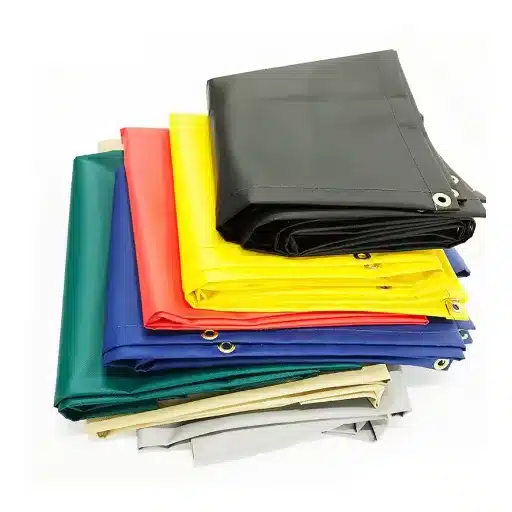
UV Resistance in Tarps: Why It Matters
UV resistance is one of the most important characteristics of tarps, but it especially holds true for outdoor applications where UV rays are unavoidably present for a long time. Over time, the sun’s ultraviolet (UV) rays can break down the materials, causing the tarp to fade, lose its plasticity, and its overall strength reduced. The UV resistant tarp is made to keep the UV rays off or endure the damage, thus, making it possible to use the tarp for a long time and making it a durable product. Recent studies have shown that UV resistant tarps can have a much longer life span than those without resistant properties, which leads to fewer purchases of new tarps and that means less spending in the long run. Furthermore, the objects on the ground get the benefit of being not only shaded but also kept away from the sun, which is vital for sensitive goods or equipment. Therefore, the UV resistance is a feature that you can never ignore, and it is equally important, no matter if you are using the tarp for the purpose of camping, covering construction sites, or even storage.
☀️ UV Resistance Benefits
✓ Prevents Fading: Maintains color and appearance over time
✓ Maintains Strength: Preserves material integrity and flexibility
✓ Extends Lifespan: Significantly longer durability compared to non-UV tarps
✓ Protects Contents: Shields stored items from harmful sun exposure
✓ Cost Savings: Fewer replacements mean lower long-term costs
✓ Versatile Use: Essential for camping, construction, and storage
Waterproof Properties and Testing
When the waterproof properties of a tarp are being considered, it is important to realize that the testing and rating of these features are likewise important. Waterproof tarps are made in such a way that they do not allow water to pass through them at all, and thus, they are perfect for the unpredictable nature of the weather and also for anything that has to remain dry. Manufacturers usually conduct tests on waterproof tarps by making it rain really hard or driving water at high pressures as a way to determine and observe the durability and effectiveness of the tarps. Moreover, to make the tarps more water-resistant and also to provide a dependable moisture barrier, coatings such as polyethylene or PVC are usually used.
According to recent searches by data from , consumers are most of the times asking what ways are available to check the waterproof quality of a tarp. A method that is quite easy involves looking through the specifications of the product to see if there are any indications such as “waterproof” or “water-resistant,” and also checking for hydrostatic pressure ratings, which show the extent to which the material can endure water pressure. Besides that, at-home real-world testing, such as pouring water on the tarp and checking for seepage, is a very practical way to guarantee that the tarp would perform as promised. A combination of lab testing and your own evaluation is the best way to ensure that your tarp will meet your particular waterproofing requirements.
💧 Waterproof Testing Methods
🏭 Manufacturer Testing
- Simulated heavy rainfall conditions
- High-pressure water application
- Hydrostatic pressure ratings
🔍 Product Verification
- Check for “waterproof” labeling
- Review hydrostatic pressure ratings
- Verify coating types (PE/PVC)
🏠 At-Home Testing
- Pour water on tarp surface
- Check for seepage or leaks
- Test in real-world conditions
The Importance of Reinforced Edges and Grommets
Reinforced edges and grommets are two characteristics that are of utmost necessity and add a lot to the durability and functionality of a tarp. A stronger edge that is reinforced may help to a great degree to eliminate the possibility of the tarp coming apart or tearing and is especially helpful in situations when the tarp is exposed to tension or the weather is very harsh. The grommets, on the other hand, are the points where the tarp is tied on, and therefore, it guarantees a setup that is both stable and reliable. Recent data from the search engine of have shown that people are often asking questions about the durability and comfort related to these features. The newest technology includes rust-resistant grommets made of metal and edges that are reinforced with such strong materials as heavy-duty polyester or double stitching, which makes the tarp more adaptable and lasting. Whether you are protecting the equipment, forming shelter, or preventing areas from getting ruined by debris, the reinforced edges and grommets are responsible for the tarp effectively serving its purpose and thus, they become very important.
🔩 Critical Reinforcement Features
🧵 Reinforced Edges
Double stitching and heavy-duty polyester prevent tearing and coming apart under tension
⚙️ Rust-Resistant Grommets
Metal grommets with rust-resistant coating provide secure, long-lasting anchor points
🛡️ Enhanced Stability
Combined reinforcement creates reliable, stable setup in harsh weather conditions
Maintenance and Care for Thick Tarps
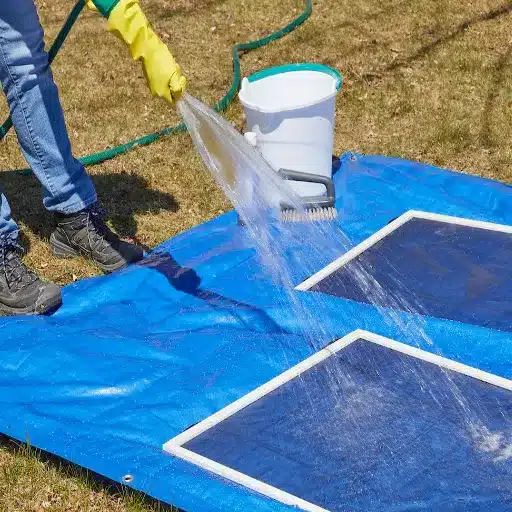
Cleaning Your Heavy Duty Tarp
A heavy-duty tarp properly cleaned will be a source of great durability and performance throughout its lifetime. Laying the tarp flat on a clean surface is the first step, and at this stage it should be free of any loose debris. The use of a mixture of mild detergent and warm water along with a soft-bristled brush or sponge will help to gently scrub the surface. Harsh chemicals or abrasive tools are a big no-no as they can cause the protective coating to come off. For mildew or stains that are too tough, vinegar diluted with water can work wonders. After cleaning, rinse with water to remove soap, and then air-dry the tarp completely before putting it away. Giving your tarp this kind of regular upkeep will not just stop mold from forming but will also prolong the existence of your tarp even when under extreme conditions.
🧼 Tarp Cleaning Step-by-Step Guide
Cleaning Process:
- Lay tarp flat on clean surface and remove loose debris
- Mix mild detergent with warm water
- Gently scrub surface with soft-bristled brush or sponge
- For tough stains, use diluted vinegar solution
- Rinse thoroughly with clean water to remove all soap
- Air-dry completely before storage
⚠️ What to Avoid:
- Harsh chemicals or bleach (damages protective coating)
- Abrasive tools or scrubbing pads
- Storing while still damp or wet
Storage Tips for Longevity
The right way of storing the tarp is to prolong its lifespan and keep the tarp’s effectiveness at its highest. To begin with, make sure the tarp is totally dry before storage preventing mold and mildew growth. After drying fold the tarp neatly following the natural seams of the tarp taking care not to create sharp creases that could weaken the material over time letting it fold up to the natural creases you just made. The tarp should be kept in a moderate, dry area away from the sun where the heat and UV light can easily penetrate and thus degrade the fabric. Besides, using a storage bag or a container can keep the tarp free from dust, pests, or moisture which adds to its protection. Following the most recent findings and insights, placing the tarp away from the spots that are often humid or suffer from temperature swings is a big plus in its durability. Last but not least, check the tarp from time to time while it is being stored to ensure it is still in good shape and you will be able to deal with any issues that come up promptly.
📦 Proper Storage Guidelines
- Ensure Complete Dryness: Prevents mold and mildew formation during storage
- Fold Along Natural Seams: Avoid sharp creases that can weaken material over time
- Choose Cool, Dry Location: Keep away from direct sunlight and UV exposure
- Avoid Temperature Extremes: Prevent damage from excessive heat or cold
- Use Storage Bag/Container: Protects from dust, pests, and environmental moisture
- Avoid Humid Areas: Moisture can compromise tarp integrity even in storage
- Conduct Regular Inspections: Check periodically for any developing issues
Repairing Damage: When to Patch or Replace
When the tarp is damaged, if it is worth patching or replacing is dictated by a number of factors like the size of the damage as well as the intend use of the tarp. As per the latest data coming from ‘s search engine, tiny rips or openings that are not more than 3 inches in size can quite often be successfully fixed using tarp tape, glue, or heavy-duty material repair kits. However, with larger rips, especially those harming integrity or coming up in high-stress areas like grommets or seams, replacement might become a foolproof solution. Besides, age is another factor; older tarps that exhibit widespread wear or UV degradation might be less effective even when patched and should be replaced to make sure that performance is not compromised. Regular assessments of damage are important in that they enable you to be both economically wise and practical while at the same time keeping the tarp’s functionality intact.
🔧 Repair vs. Replace Decision Guide
| Damage Type | Size/Severity | Recommended Action | Repair Method |
|---|---|---|---|
| Small tears/holes | Under 3 inches | ✓ PATCH | Tarp tape, adhesive, repair kits |
| Large rips | Over 3 inches | ✗ REPLACE | Consider professional repair or replacement |
| Grommet damage | High-stress area | ✗ REPLACE | Structural integrity compromised |
| Seam separation | Critical area | ✗ REPLACE | Affects overall tarp strength |
| Widespread UV degradation | Old tarp, multiple areas | ✗ REPLACE | Material integrity compromised |
Frequently Asked Questions (FAQ)
❓ What is a heavy-duty tarp, and how does it stand apart from ordinary tarps?
A heavy-duty tarp is made of thicker and tougher materials, and it often has a mil thickness of 10 mil or more, which makes it last longer than ordinary tarps. Such tarps are meant for heavy-use areas, and thus, they are able to endure rugged handling, rain and snow, and extreme conditions in general. In addition to that, they usually have aluminum grommets and double-stitched edges, which contribute to their high strength. Heavy-duty tarps can serve the purpose of covering huge machines, plus they offer the leak-proof and rip-proof barrier. Beyond that, they are multifunctional and can be used, for instance, as truck tarps or even greenhouse coverings.
❓ How can I find the right size tarp for my needs?
The proper tarp size is always determined by first measuring the place where the cover will be and then making sure that the tarp will go past the area to cover it completely. The range of tarp sizes is broad, and in some cases, such as hay or truck tarps, the right size becomes a key factor in ensuring that the desired coverage is reached. When thinking of the heavy-duty poly tarp, its microns should be taken into consideration, since heavier ones may demand a stronger base; thus the user should also be prepared to support the heavier one. Don’t just assume that the tarp size is right for your purpose and it is also suited for industrial use or light gardening; rather, check the specifications for the tarp size.
❓ What are the materials that can be used in the production of good tarps?
The most standard material for tarps is going to be woven polyethylene or heavy-duty canvas since these have properties that include being excellent for water and tearing resistance. The thickness of the material may change depending on the manufacturer but options are from 10 mil to 12 mil; thus it is possible for the buyers to opt for the thickness according to their specific needs. Some are fire retardant and can therefore be used in harsh environments requiring fire safety. Also, grommets and reinforced edges will be some of the features that may come with the tarp to prevent tearing when in use. For those wanting a waterproof tarp, options like the blue poly tarp or silver tarp are popular choices in both residential and industrial settings.
❓ Are heavy-duty canvas tarps waterproof and tear-resistant?
Heavy-duty canvas tarps do not consist of waterproof material by default, but most of them get a water-resistant treatment. Additionally, even the most reliable and strongest of tarps might succumb to moisture if not applied properly, so they need to be coated or treated once in a while. If the application requires a solution that is totally waterproof, the users would rather have the heavy-duty waterproof tarps or those made of materials like woven polyethylene. The tear-resistant feature is usually in heavy-duty tarps, thus, they will definitely be able to cope with hard usage. It is important to look at the performance criteria of each individual item to get an idea about the degree of water repellency and tear-proof ability.
❓ Can I have my tarp made to measure for specific applications?
Indeed, customization options are available in most cases when it comes to the tarps, especially in size, color, and material. Custom tarps can be developed for the most eclectic of purposes, like greenhouse coverings, specialized truck tarps, etc. Through this process, the user can decide how thick they want the mil and if they want their product to have extra features such as wind resistance or fire retardant property. When you place your order for a custom tarp, it is very important to give all the details so that what you get is exactly what you needed. Customization choices are vast and cater to both personal and industrial use, so you will always get the right tarp for your job.
Conclusion
Thick tarps represent an invaluable investment in protection, durability, and peace of mind for countless applications across residential, commercial, and industrial settings. From understanding mil ratings and material compositions to selecting the right features like UV resistance and waterproofing, this comprehensive guide has equipped you with the knowledge needed to make informed decisions. Whether you’re protecting valuable equipment, covering agricultural products, or creating temporary shelters, the right heavy-duty tarp will deliver reliable performance for years to come. Remember to prioritize proper maintenance, storage, and timely repairs to maximize your tarp’s lifespan. By choosing quality materials, appropriate thickness, and features tailored to your specific needs, you ensure that your investment provides maximum protection and value in any weather condition or challenging environment.
📚 Reference Sources
- Cornell University – Tarp Fact Sheet: This fact sheet provides detailed information on silage tarps, including their thickness, UV resistance, and applications in farming. Link to source
- Virginia Tech Extension – Tarping and Occultation Techniques in Gardening and Farming: A guide on using tarps for weed control and soil preparation in agricultural settings, highlighting their effectiveness and benefits. Link to source
- University of Minnesota Extension – Solarization and Occultation: This resource explains the use of tarps in gardening, focusing on soil heating and weed control techniques. Link to source
📋 Quick Reference: Tarp Selection Checklist
✅ Material Selection
- ☑️
Polyethylene for waterproofing - ☑️
Vinyl for industrial strength - ☑️
Canvas for breathability - ☑️
Match material to application
✅ Features to Check
- ☑️
Appropriate mil rating - ☑️
UV resistance treatment - ☑️
Waterproof certification - ☑️
Reinforced edges & grommets
✅ Maintenance Plan
- ☑️
Regular cleaning schedule - ☑️
Proper storage methods - ☑️
Timely damage repairs - ☑️
Periodic inspections
💡 Expert Pro Tips
🎯 Tip #1: Measure Twice
Always add extra coverage (at least 1-2 feet on each side) when measuring for your tarp to ensure complete protection.
🎯 Tip #2: Seasonal Rotation
Consider having different tarps for different seasons to optimize protection based on weather conditions.
🎯 Tip #3: Proper Anchoring
Invest in quality tie-downs and bungee cords to secure your tarp properly and prevent wind damage.
🎯 Tip #4: Emergency Kit
Keep a tarp repair kit handy with patches, tape, and adhesive for quick fixes in the field.

